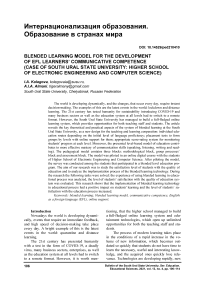Blended learning model for the development of EFL learners’ communicative competence (case of South Ural State University: higher school of electronic engineering and computer science)
Автор: Kolegova I.A., Almani A.I.A.
Рубрика: Цифровизация в образовании
Статья в выпуске: 4 т.13, 2021 года.
Бесплатный доступ
The world is developing dynamically, and the changes, that occur every day, require instant decision-making. The examples of this are the latest events in the world: lockdown and distance learning. The 21st century has tested humanity for sustainability introducing COVID-19 and many business sectors as well as the education system at all levels had to switch to a remote format. However, the South Ural State University has managed to build a full-fledged online learning system, which provides opportunities for both teaching staff and students. The article reveals the key theoretical and practical aspects of the system of blended learning at the South Ural State University, as a new design for the teaching and learning cooperation: individual education routes depending on the initial level of language proficiency; placement tests to form groups by levels with online support for them; appropriate score-rating system for monitoring students' progress at each level. Moreover, the presented level-based model of education contributes to more effective mastery of communication skills (speaking, listening, writing and reading). The pedagogical model contains three blocks: methodological block, group processes’ block and assessment block. The model was piloted in an online digital course with the students of Higher School of Electronic Engineering and Computer Science. After piloting the model, the survey was conducted among the students that participated in a blended level education program. The aim of our research was to study the satisfaction level of students with the quality of education and to analyze the implementation process of the blended learning technology. During the research the following tasks were solved: the experience of using blended learning in educational process was analyzed, the level of students’ satisfaction with the quality of education system was evaluated. This research shows that the implementation of blended learning technology in educational process had a positive impact on students' learning and the level of students` satisfaction with the education process increased.
Blended learning, blended learning model, communicative competence, english as a foreign language (efl), online support
Короткий адрес: https://sciup.org/147236468
IDR: 147236468 | DOI: 10.14529/ped210410
Список литературы Blended learning model for the development of EFL learners’ communicative competence (case of South Ural State University: higher school of electronic engineering and computer science)
- Ahmed S.T.S. Communicative Competence in English as a Foreign Language: It's Meaning and the Pedagogical Considerations for its Development. The Creative Launcher, vol. 2, 2018. Available at: https://www.researchgate.net/ publication/324392820.
- Allen I.E., Seaman J., Garrett R. Blending in: The extent and promise of blended education in the United States. Needham, MA: Sloan Center for Online Education Publ., 2007. 29 p.
- Alexio M.B. Teachers' attitudes of communicative language teaching use in Brazil. Unpublished MA thesis. West Virginia, US, West Virginia University Publ., 2003. Available at: https://researchrepository.wvu.edu/etd/719.
- Aspden L., Helm P. Making the Connection in a Blended Learning Environment. Educational Media International, 2004, no. 41 (3), pp. 245-252. Available at: http://www. tandfonline.com/doi/abs/10.1080/0952398041 0001680851. DOI: 10.1080/095239804100016 80851
- Babb S., Stewart C., Johnson R. Constructing Communication in Blended Learning Environments: Students' Perceptions of Good Practice in Hybrid Courses. Journal of Online Learning and Teaching, 2010, vol. 6, no. 4, pp. 735-753.
- Bersin J. The Blended Learning Book: Best Practices, Proven Methodologies, and Lessons Learned. Pfeiffer John Wiley & Sons Publ., 2004.319 p.
- Boelens R., Van Laer S., De Wever B., Elen J. Blended Learning in Adult Education: Towards a Definition of Blended Learning. Available at: https://biblio.ugent.be/publication/ 6905076 (accessed: 05.02.2020).
- Boyle T., Bradley C., Chalk P., Jones R., Pickard, P. Using Blended Learning to Improve Student Success Rates in Learning to Program. Journal of Educational Media, 2003, no. 28 (2-3), pp. 165-178. Available at: http://www. tandfonline.com/doi/abs/10.1080/1358165032 000153160. DOI: 10.1080/1358165032000 153160
- Chandra V., Fisher D.L. Students' perceptions of a blended web-based learning environment. Learning Environments Research, 2009, no. 12 (1), pp. 31-44. Available at: http://link. springer.com/article/10.1007/s10984-008-9051-6 (accessed: 24.09.2021).
- Deegan D., Wims P., Pettit T. The Potential of Blended Learning in Agricultural Education of Ireland. International Journal of Agricultural Science, Research and Technology in Extension and Education Systems, 2015, vol. 5, iss. 1, pp. 53-64. DOI: 10.18765/jes.v30i2.5473
- Garnham C., Kaleta, R. Introduction to Hybrid Courses. Teaching with Technology Today, 2002, vol. 8, no. 6. Available at: http://www.uwsa.edu/ttt/articles/garnham.htm.
- Gilbert J., Flores-Zambada R. Development and Implementation of a "Blended" Teaching Course Environment. Journal of Online Learning and Teaching, 2011, vol. 7, no. 2, pp. 244-260.
- Gomes T., Panchoo P. Teaching Climate Change Through Blended Learning: A Case Study in a Private Secondary School in Mauritius. IEEE, 2015, pp. 1-5. DOI: 10.1109/cccs.2015.7374179
- Johnson C., Marsh D. Blended Language Learning: An Effective Solution but not Without Its Challenges. Higher Learning Research Communication, 2013, no. 3, vol. 4. Available at: https://www.researchgate.net/publication/ 291100783 (accessed: 12.09.2021).
- Nuttall C. Teaching Reading Skills in a foreign language. Oxford: Heinemann, 1996. 292 p.
- Picciano A., Dziuban C. Blended Learning: Research Perspectives. Needham, MA: Sloan Center for Online Education Publ., 2007. 312 p.
- Richards J. Communicative Language Teaching Today. Cambridge University Press, 2006. 52 p.
- Rudestam K.E., Schoenholtz-Read J. The Flourishing of Adult Online Education: An Overview. Los Angeles, CA, Sage Publ., 2010. DOI: 10.1111/j.1467-8535.2010.01060_12.x
- Sharma P., Barett B. Blended Learning (Books for Teachers). London, Macmillan ELT Publ., 2007. 160 p.
- Spada N. Communicative Language Teaching: Current Status and Future Prospects. International Hand Book of English Language Teaching (Part I). New York, Springer Publ., 2007. 87 p.
- Stockwell B.R., Stockwell M.S., Cennamo M., Jiang E. Blended Learning Improves Science Education. Springer Open, 2015, release 162 (5). Available at: https://www.ncbi. nlm.nih.gov/pubmed/26317458 (accessed 25.02.2020). DOI: 10.1016/j.cell.2015.08.009
- Watson, J. Blended Learning: The Evolution of Online and Face-to-Face Education from 2008-2015. Available at: https://aurora-institute.org/wp-content/uploads/iNACOL_ Blended-Learning-The-Evolution-of-Online-And-Face-to-Face Education-from-2008-2015 (accessed: 30.07.2021)


